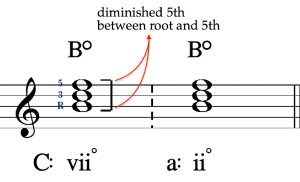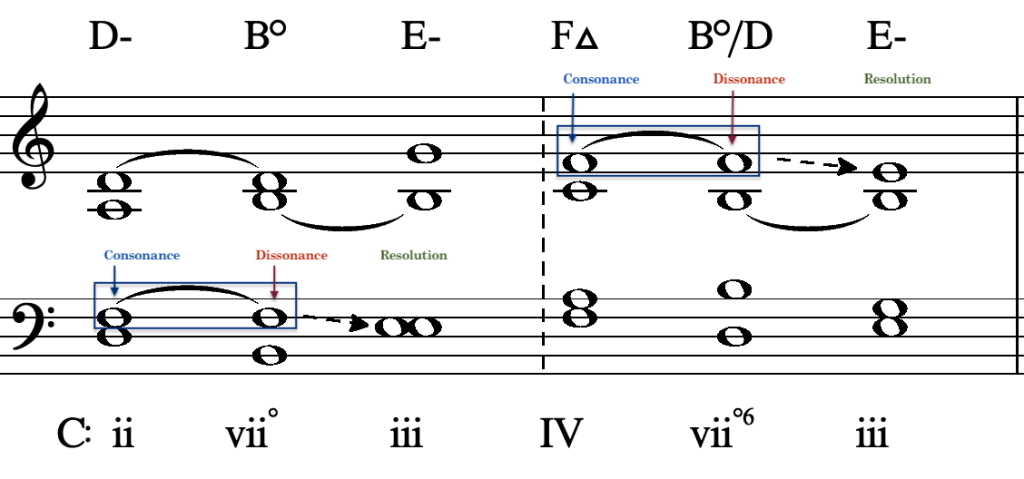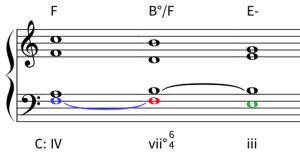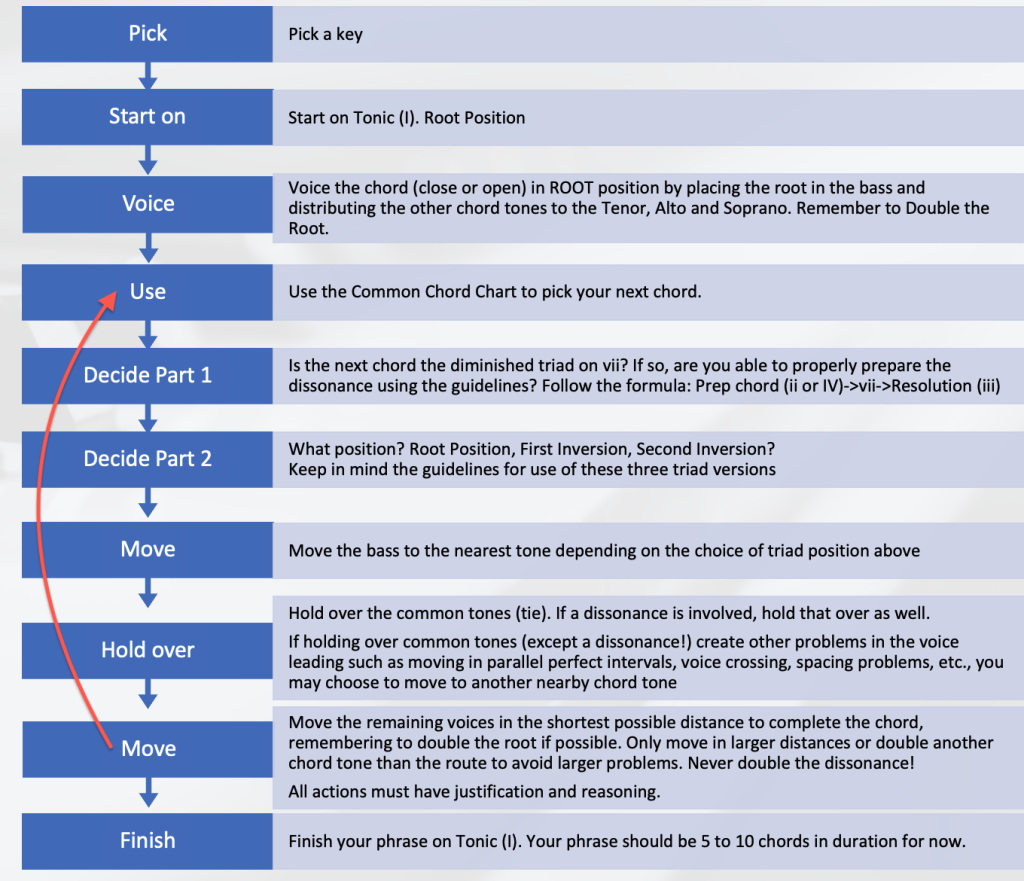Western Harmonic Practice I: Diatonic Tonality
9 Harmonic Dissonance I: The Diminished Triad
Key Points
Here we learn how to work with a harmonic dissonance in a chord, starting with the diminished fifth as part of the leading tone diminished triad.
- Harmonic Dissonance: A chord tone which forms a dissonant harmonic interval in relationship to the root of the chord
- The leading tone diminished triad found in the diatonic major mode built on scale degree

- Preparation and Resolution Modeling for the handling of harmonic dissonances in diatonic tonal music:
- Locating the pitch (scale degree) which forms the dissonance sounding as a consonant chord tone in the preceding chord
- Holding over via suspension (similar to fourth species counterpoint) as a tie into the dissonant chord
- Resolving the dissonance melodically by stepwise motion downward into a consonant chord tone in the subsequent chord
In this chapter we will learn how to both incorporate and handle a dissonance in a chord, specifically the dissonance of the diminished fifth found between the root and fifth chord tones of the diminished triad which is built on scale degree ![]() in the major diatonic mode. In essence, in tonal music, a harmonic dissonance occurs when we have a dissonance formed between the root and the dissonant chord tone. In the case of the diminished triad, that dissonance is between the root and the fifth. In the next chapter we will introduce the seventh chord, a four note tertian harmony that adds a chord tone a distance of a third above the fifth chord tone of a triad, forming a dissonant interval of a seventh in relationship to the root. The process of handing harmonic dissonances is the same regardless of which chord tone(s) are dissonant.
in the major diatonic mode. In essence, in tonal music, a harmonic dissonance occurs when we have a dissonance formed between the root and the dissonant chord tone. In the case of the diminished triad, that dissonance is between the root and the fifth. In the next chapter we will introduce the seventh chord, a four note tertian harmony that adds a chord tone a distance of a third above the fifth chord tone of a triad, forming a dissonant interval of a seventh in relationship to the root. The process of handing harmonic dissonances is the same regardless of which chord tone(s) are dissonant.
Why Dissonance?
It may well be asked why we might wish to introduce anything that may sound “dissonant” in the first place. While this topic was briefly touched on in our discussion regarding dissonance in counterpoint, it is important to understand why dissonance is important in music and why we also, at least within the framework of our simple SATB exercises (and, earlier, in our counterpoint exercises), developed these guidelines for any dissonant tone’s careful handling.
First of all, the concept of dissonance in music is relative and context driven. Remember: Context matters. These first steps we are taking into the world of chords labeled as dissonant, such as the diminished triad, and later, the seventh chord, are not really all that bad sounding. They might sound, depending on the context, somewhat “unsettled,” but not necessarily bad and, as such, it should be further understood that dissonance in and of itself does not equate to “bad” any more than consonance might equate to “good.” What is important to understand is that, in context, especially within a simple, diatonic, and tonal context such as the one in which we are currently working, these chords introduce a kind of instability that is not found in the other chords, with the possible exception of the second inversion triad which we addressed in the previous chapter. This instability, and the dissonance which lends to this instability, has the effect of drawing attention and, therefore, demands a solution, a resolution. It is, in fact, the nature of this kind of instability through dissonance and other elements which gives music a forward sense of momentum through time and helps propel a sense of narrative flow.
Within a much larger picture, dissonance and instability plays a role in music not unlike that of tragedy or setback in our daily life. As the 19th century American poet Henry Wadsworth Longfellow put, “into each life, some rain must fall.” It is often through adversity that growth and development is spurred and, further, life’s triumphs and victories are given even more meaning through this contrast. Even death itself can be said to give life its full meaning by its acute framing of our finite time.
The Diminished Triad
As we learned in Fundamentals, the diminished triad is named as such because of the diminished fifth which is formed between the root and fifth of the chord. In contrast to the stable perfect fifth found in both major triads and minor triads, this diminished fifth (the interval is also known as a tritone) is unstable and is characterized as a dissonance. This chord occurs naturally when we construct a triad on the leading tone, scale degree ![]() in major, and on the supertonic, scale degree
in major, and on the supertonic, scale degree ![]() in minor. We will address the minor mode in detail in a later chapter.
in minor. We will address the minor mode in detail in a later chapter.
Figure 1. The diminished triad. Shown in C major and A minor for example.
We label the diminished triad in Roman numeral notation with a lowercase number matching the scale degree on which the chord is built, as we would do with a minor triad, but we further add a to the right in superscript to tell us that the chord’s quality is diminished. In the major mode, since we find this chord on scale degree ![]() we write vii as our Roman numeral analysis notation. The lead sheet chord notation will show the pitch class on which the chord is built followed similarly by a superscript to indicate the diminished chord quality. In the figure above, the B diminished triad is labeled B.
we write vii as our Roman numeral analysis notation. The lead sheet chord notation will show the pitch class on which the chord is built followed similarly by a superscript to indicate the diminished chord quality. In the figure above, the B diminished triad is labeled B.
Preparation and Resolution of the Dissonance
The general process for handing a harmonic dissonance of any kind is similar to process of working with a strong beat dissonant interval in Fourth Species Counterpoint. In fourth species, a dissonant interval on a strong beat was prepared by sounding the note to become a dissonance as a consonance on the preceding weak beat. The tone which becomes dissonant is then held over by tie (i.e. suspended, hence suspension) into the strong beat and the dissonance is formed by movement in the cantus firmus line. The resolution to this dissonant interval is achieved in the subsequent weak beat where the counterpoint melody forming the dissonance with the cantus firmus is moved downward by step into a consonant harmonic interval.
Example 1. Dissonant suspension: Preparation and Resolution in Counterpoint
In four part SATB chorale style, we accomplish something similar to the suspension process learned in species counterpoint by choosing a chord that contains the pitch class that will become dissonant in the dissonant chord preceding its arrival. After sounding the dissonant chord, we resolve this dissonance by moving the voice containing the dissonance downward by step into a consonant chord that contains the resolving pitch.
Voice Leading the Diminished Triad
To accomplish the successful handling of the diminished triad, and specifically the leading tone diminished triad on scale degree 7 in major, we should first look at which chords have common tones with vii via the common tone chord chart:
Common Tone Chord Chart (Major Mode)
| Chord | Has common tones with... | |||
|---|---|---|---|---|
| I | iii | IV | V | vi |
| ii | IV | V | vi | vii |
| iii | I | V | vi | vii |
| IV | I | ii | vi | vii |
| V | I | ii | iii | vii |
| vi | I | ii | iii | IV |
| vii | ii | iii | IV | V |
Note that the highlight from previous version of this chart is now removed as we are able to use this chord in our four part tonal phrases.
Preparation
We need to identify chords which not only share tones in common, but specifically chords that share the dissonance of the triad, the diminished fifth, as a common tone. This is easily found by examining the composition of the leading tone triad in regard to the which scale tones are present as chord tones:
- root = scale degree

- third = scale degree

- fifth = scale degree


This means we need a preparation chord that also contains scale degree ![]() as one of its chord tones. From the above common tone chart we can further examine which chords would contain scale degree
as one of its chord tones. From the above common tone chart we can further examine which chords would contain scale degree ![]() :
:
| Common Tone Chords connecting to the Leading Tone vii | Chord Tones and Scale Degrees |
|---|---|
| ii | Root: |
| iii | Root: |
| IV | Root: |
| V | Root: |
We can see that both the supertonic (ii) and submediant (vi) both contain scale degree ![]() which, when connected to the leading tone diminished triad will become the dissonant fifth chord tone.
which, when connected to the leading tone diminished triad will become the dissonant fifth chord tone.
Example 2. Preparation of the diminished fifth of the diminished triad in C major
Example 2 above shows two preparations of the leading tone diminished triad and its diminished fifth dissonant chord tone, one using the supertonic (ii) and the other using the submediant (IV). The key is C major and the scale degree ![]() is pitch class F. Notice that the F, the third chord tone in the D minor chord ties over in a similar way as a suspension in fourth species counterpoint, into the dissonant F, the fifth chord tone of the B diminished triad.
is pitch class F. Notice that the F, the third chord tone in the D minor chord ties over in a similar way as a suspension in fourth species counterpoint, into the dissonant F, the fifth chord tone of the B diminished triad.
Resolution
After sounding the diminished triad, we must then voice lead whichever voice containing the chord tone of the diminished fifth dissonance in the diminished triad downward by step, resolving to a consonant chord tone in the subsequent chord. Again, an examination of the common tone chord connection chart shows us that the supertonic (ii), mediant (iii), subdominant (IV), and dominant (V) all have common tones with the leading tone (vii) triad and could therefore act as potential destinations for a resolution. However, as we must step downward from the dissonant diminished fifth chord tone, which in the major mode is scale degree ![]() , we must find a chord that has at least one common tone and contains scale degree
, we must find a chord that has at least one common tone and contains scale degree ![]() as one of its constituent chord tones. Let’s again check the reference chart of chord tones in the common tone chords we encountered above, this time in search of resolution chords containing scale degree
as one of its constituent chord tones. Let’s again check the reference chart of chord tones in the common tone chords we encountered above, this time in search of resolution chords containing scale degree ![]() as a chord tone:
as a chord tone:
| Common Tone Chords connecting to the Leading Tone vii | Chord Tones and Scale Degrees |
|---|---|
| ii | Root: |
| iii | Root: |
| IV | Root: |
| V | Root: |
On examination, we see that the mediant (iii) is our only option as it is the only chord which has both common chord tones to the leading tone (vii) and scale degree ![]() as one of its chord tones.
as one of its chord tones.
Example 3. Two examples of Preparation and Resolution of the diminished triad in C major
Example 3 above shows the same two preparations we encountered in Example 2, but now continued onward to the resolution chord of the mediant triad (iii), which is an E minor triad in the key of C major. In both cases, the dissonant chord tone, the pitch class F which is scale degree ![]() in the key, falls to E in the resolving chord (scale degree
in the key, falls to E in the resolving chord (scale degree ![]() ). Notice, too, that, in the second example, the B diminished chord is in first inversion with a pitch D, the third chord tone, in the bass voice.
). Notice, too, that, in the second example, the B diminished chord is in first inversion with a pitch D, the third chord tone, in the bass voice.
Inversions of the Diminished Triad
Example 3. The “Six-Four” version of the diminished triad shown here, prepared and resolved in C major.
Blue=Prep / Red=Dissonance / Green=Resolution
Guidelines: Summary
We can summarize what we learned above in. a three step process as follows:
- Prepare the dissonance by sounding it first in a preceding chord as a consonant tone and then tying it over as a common tone. For the leading tone diminished triad we are looking for scale degree 4 and the two preparation chords we may use are the supertonic (ii) and subdominant (IV)
- Sound the diminished triad on vii by holding over the dissonance and any other common tones, moving the other voices to the nearest chord tone to complete the chord. Double the root when at all possible; exception may be the third when other solutions are more problematic. Never double a dissonance: The fifth of this chord will never be doubled under any circumstance
- Resolve by going to the mediant (iii) chord, moving the voice containing the dissonant chord tone downward by step, holding over any tones in common, and moving the other voices to the nearest available chord tone. Again, mindful of trying to double the root when possible.
Chord Connection Guidelines: V3
Now that we have added the leading tone diminished triad to our list of possible tonal ingredients, the process of moving from one chord to another in short tonal phrases may be expanded now, including everything we have learned thus far. Here is an updated flowchart:
Common Tone Chord Chart (Major Mode)
| Chord | Has common tones with... | |||
|---|---|---|---|---|
| I | iii | IV | V | vi |
| ii | IV | V | vi | vii |
| iii | I | V | vi | vii |
| IV | I | ii | vi | vii |
| V | I | ii | iii | vii |
| vi | I | ii | iii | IV |
| vii | ii | iii | IV | V |
EXAMPLES
Phrases in C Major, G Major, and F Major using a mixture of Root, 1st and 2nd Inversion Triads, and the Diminished Triad
If the score above is not displaying properly you may CLICK HERE to open it in a new window.
RWU EXERCISES
Mixed Triads with the Diminished Triad in the Major Mode
Using the template below, do the following:
- Realize the given harmonic progression (the Roman numeral analysis is provided).
- Compose three harmonic progressions of your choice, one may be in C Major, and the other two any major key of your choosing.
- Follow the guidelines set above.
- You must have at least one instance of a first inversion (“Six” chord) and one instance of a second inversion (“Six-Four” chord) triad in each of your phrases, properly handled and voice led.
- You must have at least one instance of a leading tone diminished triad in each of your phrases, properly prepared and resolved according to the guidelines above.
(you must be logged into your Noteflight account to open the activity templates above)
Schoenberg Theory of Harmony Examples
Further Reading
- Schoenberg, Arnold: Theory of Harmony
- Schoenberg, Arnold: Structural Functions of Harmony
a dissonant interval found in a chord, typically in relationship to the root of the chord.
Any combination of two or more pitch classes that sound simultaneously.
An interval that is spelled as a fifth with a distance of six (6) half steps, one half-step shy of a perfect fifth. We also call this distance a tritone (three whole steps).
A 7̂ that is one half step below 1̂. The leading tone is diatonic in major keys, but requires an accidental in minor keys.
A triad whose third is minor and fifth is diminished.
A perceived quality of auditory roughness in an interval or chord.
The lowest note of a triad or seventh chord when the chord is stacked in thirds.
A pitch (pitch class) in tertian harmony located the distance of a fifth (perfect, augmented, or diminished) above the root.
A pitch that belongs to a chord. Example: a c major triad has three chord tones, pitch-classes C, E, and G.
The relative position of a note within a diatonic scale. Indicated with a number, 1–7, that indicates this position relative to the tonic of that scale.
An ordered collection of half steps (H) and whole steps (W) as follows (ascending): W–W–H–W–W–W–H.
the art or technique of setting, writing, or playing a melody or melodies in conjunction with another, according to fixed rules. Literal meaning is "point against point" which we interpret as "note against note"
A four part musical texture with soprano (S), alto (A), tenor (T), and bass (B) parts, abstracted through voice.
A triadic (or tertian) harmony with the fifth in the bass
Perfect Fifth
A triad whose third is major and fifth is perfect.
A triad whose third is minor and fifth is perfect.
the second scale degree of the diatonic major or minor mode, a step above the tonic and a fifth above the dominant.
A way of labeling chords according the the scale degree upon which the chord is built in tonal music. The scale degree number is represented as a Roman numeral as opposed to an Arabic numeral and the case of the Roman numeral is often used to denote the quality of the chord with Upper Case as major and Lower Case as minor.
A perceived quality of auditory roughness in an interval or chord, relative to the surrounding musical texture.
The distance between two notes.
In a given meter, it is beat which is stressed (given emphasis).
As an acoustic phenomenon, frequencies vibrating at whole-number ratios with one another; as a cultural phenomenon, perceived stability in a chord or interval.
In a given meter a beat that is unstressed (not emphasized).
An embellishing tone that is approached via static note and left by step down. The suspension is on a strong part of the beat.
Literally meaning “fixed voice," this is a pre-existing melodic line that serves as the basis for a new counterpoint exercise or other composition.
A perceived stability or smoothness in a chord or interval relative to the surrounding musical texture.
A traditional approach to music composition pedagogy focused on counterpoint as a way of learning to think of music horizontally (melodically) and vertically (harmonically) simultaneously. Consists of five “species,” each of which focuses on a single compositional element.
scale degree 6 of the diatonic major and minor modes, a fifth below the mediant and a third below the tonic
scale degree 3 in the diatonic major and minor modes, located a third above the tonic, and a fifth above the submediant.






